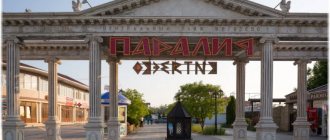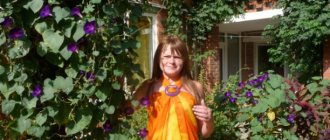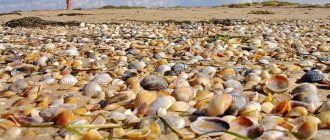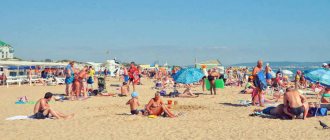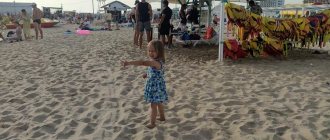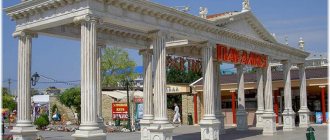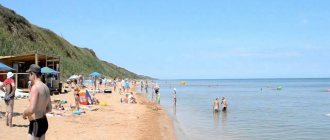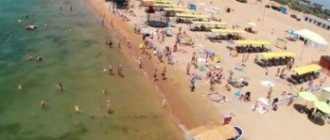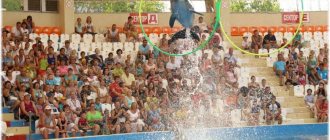Vityazevo from A to Z: sea and beaches, hotels, sanatoriums, hotels and boarding houses in Vityazevo, reviews. Shops and restaurants, prices in Vityazevo.
- Last Minute Hotels
in Krasnodar Region
11 km from Anapa is the quiet and comfortable resort village of Vityazevo. It is considered a Greek settlement, most of the local residents are Russified Pontic (Black Sea) Greeks, which left its mark on the architecture of the resort and the cultural traditions of the village.
The village of Vityazevo received its current name in honor of the hero of the Russian-Turkish war, Major Vityaz. In 1809, in the battle near Anapa, he showed courage, repelling the attack of the Circassians. On this very spot in 1837 the Cossack village of Vityazevskaya was founded.
The village is located along the banks of the Vityazevsky estuary. The sea here is clean, shallow and warms up very quickly. The Caucasus ridge does not come close to the sea, which is why the resort is surrounded not by mountains, but by vineyards - this makes the area look like a Mediterranean one.
How to get to Vityazevo
When going to Vityazevo, we are heading for Anapa: more details here.
It is convenient that the Anapa railway station and the local airport are located closer to Vityazevo than the resort town itself. Most guest houses are willing to organize a free transfer. The cost of an official taxi from the airport to Vityazevo (only 5 km of travel) is 600 RUB, with private owners you can negotiate for 400 RUB or less, from the station (6 km) - you need to bring the price down to at least 350 RUB. Mostly, vacationers travel here by train to the Tonnelnaya station, which is located about 35 km from Anapa and 50 km from Vityazevo. A taxi from Tunnelnaya to Vityazevo costs 850-900 RUB if you book in advance.
For travel by minibus from Tonnelnaya to Anapa bus station they charge from 120 RUB. From there, minibuses No. 114, 128, 134 go to Vityazevo every 10 minutes. You can board in the center of Anapa or on Pionersky Prospekt. However, they cover a distance of 15 km in 30-40 minutes, or even longer.
Vityazevo is located at the very end of Pionersky Prospekt, along which boarding houses and hotels line one after another. During the season, minibuses are crowded. The fare from Anapa to Vityazevo is from 40 RUB, sometimes it’s easier to take a taxi - from 350 RUB.
Search for cheap flights to Vityazevo
Comparison criteria
Before you start comparing which is better - Dzhemete or Vityazevo, you need to determine the parameters by which they will be compared. First of all, this:
- Distance from Anapa.
- Beaches and their condition.
- Entertainment.
- Treatment. Availability and quality
- Nutrition. Quality and cost.
- Accommodation prices.
So where is it better and cheaper: in Dzhemete or Vityazevo? Let's try to figure this out. Of course, any village has its admirers and opponents, but newcomers want to know more about each village.
Transport
There is only one regular bus running through the village, No. 114, the route of which completely coincides with the route of a minibus with the same number. It connects the Paralia embankment with the central part of Anapa (bus station and several markets). Minibus No. 128 repeats this pattern, but departs from the beach in Vityazevo. Route No. 134, which also goes to Anapa, makes its final stop in the village at the Aquamarine sanatorium.
“Anapa” routes are very useful and those who spend their entire vacation in Vityazevo can use them to move around the village. The fact is that internal, seasonal minibuses No. 23 and No. 23a are too busy and cannot cope with the flow of people who want to leave the sea deep into the village. The cost of travel within Vityazevo in both cases does not exceed 15 RUB.
It is easier to travel between coastal villages by taxi - you will have to get by public transport through Anapa. The cost of a trip between villages along the coast is from 150-600 RUB.
An equally convenient option is a bicycle. There are both separate rental centers and points at hotels. An hour costs from 50 RUB, 3 hours - from 100 RUB, a day - from 300 RUB.
Antique period
It so happened historically that different peoples lived in this territory. About two thousand years ago the Sindians lived here, and on the site of the modern city there was the ancient ancient city of Sindika (Sindian Harbor).
In the 14th century, the city was a Genoese colony of Mapa, where Genoese and Jews lived. It was the Genoese who built strong fortifications, which can be seen on ancient Visconti tarot cards as the Mapa fortress. In the same 14th century, Tamerlane walked through these places “with fire and sword”, who, having destroyed everything, left the fortifications unharmed.
Vityazevo Hotels
According to the traditions of seaside towns, everything in Vityazevo is for rent (rooms, apartments, houses), and what is not for rent is under construction and will soon be rented out. There are no more than 20 star-rated hotels in the village, hundreds of mini-hotels and guest houses.
The most common option: the master's house, surrounded by guest buildings, with a summer kitchen and a dining area covered with ivy or grapes. The “room stock” consists of rooms of varying degrees of comfort. Accommodation in a small room without amenities (no private toilet, shower, refrigerator and air conditioning) - from 400 RUB per person in high season. Room “with amenities” - from 800 RUB per person.
Despite the fact that the choice is large, and prices are very reasonable even during the season, it is better to book interesting options in advance. Rooms in facilities with developed children's infrastructure run out quickly.
Newly built hotels follow each other fence to fence. On the territory there may be several residential buildings, a dining room and a cafe, one or two swimming pools (usually tiny), and a children's playground. Sometimes hotels have a private beach. Unfortunately, most “new buildings” do not have enough territory: little greenery, a minimum of parking spaces. Cost - from 2500 RUB per room.
In the village itself it is easy to rent an apartment - from 2000 RUB; in the surrounding area there are several resort hotels and modern boarding houses - from 3500 RUB for a double room.
Ethnic composition
According to statistics, as of 2016, 176,210 people lived in the urban district, including the population of Anapa was 73,410 people and in rural areas - 102,800 people. According to the 2010 census, more than 86% of Anapa residents are Russian, about 7% are Armenians, 2% are Ukrainians, and 5% are other nationalities.
The city is home to Belarusians, Tatars, Jews, Greeks, Georgians and Gypsies. In recent years, statistics have shown an increase in migrants due to the population of the former Soviet republics: Uzbeks, Tajiks, Kyrgyz, Azerbaijanis.
Rent a Car
You can rent a car directly in Vityazevo or in the surrounding area: at Anapa airport, in the neighboring village of Dzhemete. Local and international franchise companies (Europcar, Sunnycars, Hertz) offer their services.
An economy class car (5-door sedan) costs from network companies on average from 2800 RUB per day, from private companies - from 2500 RUB (a domestic car is cheaper - from 1500 RUB). The latter offer a more flexible system of discounts: you save 200-300 RUB per day when renting a car for at least 2-3 days. In addition, they also offer hourly rentals - from 300-450 RUB per hour.
If the “network operators” will definitely take the credit card information and freeze the deposit on it, then private rental companies are ready to accept a deposit in the form of cash.
There are few organized public parking areas, both paid and free, on the coast. Therefore, they put it as necessary. The parking lots at the guest houses are occupied by guests' cars during the season. In areas closed to traffic, parking may be paid. Thus, parking at the Bolshoy Utrish nature reserve costs from 400 RUB. In the morning and evening hours, traffic jams may form near Anapa.
Demography
Every year the population of Anapa increases by an average of 3,000 people. Moreover, this is a natural increase, which indicates that the birth rate exceeds the death rate. This demographic situation has been observed in Anapa for several years now, which indicates an increase in the level of the socio-economic situation.
According to statistics, in recent years the number of registered marriages has increased compared to the number of divorces, which undoubtedly shows an increase in the status of the family and the general economic condition.
Vityazevo beaches
The beach is both the calling card and the Achilles heel of the village. On the one hand, tourists with small children come here for the wide (up to 150 m) beach with dunes of snow-white sand. The sea is shallow hundreds of meters from the shore, the water is clear. But the beach does not always look like this: during the season the picture deteriorates sharply.
Convenient access from the village is organized only to the Central Beach - therefore, vacationers are grouped here. There is not enough space even for those who paid for a sunbed (from 200 RUB), small debris accumulates in the sand. Water in shallow water can “bloom” at any moment, filling with algae that looks like mud. The greatest probability is from the end of June until the second half of August.
Exit: go by water as far as possible from the crowd (traders agree to look after baby strollers for 50 RUB). Get to the wild beaches behind the Vityaz health resort (towards Blagoveshchenskaya). Go to the pebble beaches, which start in Anapa and stretch to Bolshoi Utrish.
Vacationers even use the beaches of children's health resorts - during hours when there are no children on the beach, there is no entry control. The private beaches of hotels are closed to outsiders.
Alternative. Get there by minibus or car (travel for drivers with non-Anapa registration is 100 RUB). There are fewer people, the sea is cleaner, and the range of entertainment (trampolines, inflatable slides, all kinds of water “transport”) is the same as on the main beach. Here children can look for treasures with pirate animators.
- Does the sea bloom in Vityazevo
Treatment in Vityazevo
The Vityazevsky Estuary, next to which the village is located, is a source of healing hydrogen sulfide mud used to treat diseases of the musculoskeletal system, nervous and cardiovascular systems, gynecological problems, skin and eye diseases, chronic diseases of the digestive and respiratory organs.
Mud therapy is practiced by most local sanatoriums; there are also private cosmetology and medical offices. In addition, vacationers themselves smear themselves on the beaches of the estuary from head to toe, paying attention to problem areas (usually joints), and collect dirt in containers for future use.
An even more popular source of healing mud in these parts are mud volcanoes. There are more than 20 of them, located mainly on the other side of the Vityazevsky Estuary on the Taman Peninsula. Most often, tourists are taken to the Tizdar volcano near the village of Za Rodinu - the infrastructure for mud procedures is better developed here, and you can wash yourself in the Sea of Azov.
About an hour's drive from Vityazevo is the Shugo volcano. Its mud is considered one of the most beneficial in terms of its chemical composition; it is what the region’s health resorts prefer to use. There are not even showers on Shugo to wash off the dirt; it is recommended to bring water with you.
Regardless of which volcano the procedure takes place on, you should not keep the dirt on the skin for more than 15 minutes. Then it is recommended to rinse it thoroughly.
For systemic treatment, it is better to purchase a ticket to a sanatorium or a course with an included set of procedures. There are three sanatoriums in Vityazevo: Vityaz, owned by Gazprom, Aquamarine, which serves Russian Railways, and the Dunes children's health resort, which also accepts families with children. Cost of living: during the season from 5000, 4000 and 2000 RUB per person per day, respectively.
Nutrition
Either in Dzhemete or in Vityazevo, eating good and tasty food is not a problem. There are many different food outlets here, as they say - for every budget. Both villages have everything from expensive restaurants to street fast food.
For the most fastidious people there is the opportunity to choose an establishment to suit their taste. Russian, European, Asian, and Caucasian cuisine is served here. High-quality food in sanatoriums and boarding houses. There are many local fruits in season. Dzhemete and Vityazevo are famous for their vineyards.
Cafes and restaurants Vityazevo
The first thing that characterizes local cuisine is that it fits perfectly into the budget. There are no restaurants in the traditional sense here, but a huge number of canteens makes it possible to easily organize three meals a day. For one person - from 150-200 RUB for lunch, from 250-300 RUB - for dinner with beer.
On the beach, food is served by merchants (corn - from 50 RUB, churchkhela - from 100 RUB), on the embankment there are many stalls with all kinds of snacks, southern sweets - baklava and chak-chak (from 50 RUB).
Fearing intestinal infections, many tourists prefer to eat according to a custom menu from the hosts or cook themselves. Prices in guest houses are either the same or slightly higher than in canteens (from 150 to 450 RUB per person for lunch/dinner).
Despite the large number of “Greek” names for cafes and canteens, Greek cuisine in the village, with rare exceptions, is poorly presented: by it most “restaurateurs” understand Greek salad with sunflower oil.
There are not enough quality cafes with good cuisine in the village. The Dublin pub with a decent beer list, the chain establishment Yayem (pizza, sushi, Greek gyro), and the Macedonia cafe, which still praises the same kebab, deserve special mention.
Entertainment and attractions
All roads in Vityazevo converge on Paralia, which is translated from Greek as “embankment” and appears as an embankment in guidebooks. In fact, this is a boulevard that stretches 800 m from the center of the village towards the sea and ends at the Central Beach. Paralia takes its beginning from Southern Avenue. There are a number of shops, cafes, shopping malls, and souvenir stalls lined up here. An amusement park and a dolphinarium were built right there. During the season, the “embankment” is crowded and loud: barkers, photographers with exotic animals and even “living statues” attack, many of which, however, are not only friendly, but also original.
Another local “celebrity”, the winery, has stopped producing its own wines and is producing raw materials for other factories in the region. The company store remained with him - wine in bottles, although Krasnodar, was imported.
For other attractions, you need to go to Anapa (a complex of fountains, a lighthouse, “Gorgippia”) or to Sukko, where in the specially built Lion’s Head castle, professional actors organize knightly tournaments with a plot for tourists. If possible, it is better to choose an evening show, as it is more spectacular. After the tournament, guests are offered additional atmospheric entertainment: modeling in a pottery workshop, working in a forge, and archery. Not far from the castle there is a picturesque mountain lake.
The road beyond Sukko soon ends and the territory of the Bolshoy Utrish nature reserve begins. Just for the sake of these rocky landscapes it was worth going to the Anapa coast. The narrow line of the beach ahead is cut off by the Navagirsky ridge, with forest approaching from all sides.
They offer diving lessons, fishing, and mountain climbing with an instructor. Unfortunately, campers leave trash behind at campsites. Local residents complain that the wild beauty of these lost places risks disappearing in the next decade.
After the Crimean War
People gradually began to return to Vityazevo, but only in 1862, that is, actually 9 years after the evacuation, the settlement of Vityazevo appeared on the site of the village, the basis of which was the Pontic Greeks - everything returned to normal. The number of vineyards in the settlement increased significantly; local residents equipped wine cellars and built 18 windmills.
Vityazevo for children
Life in a seaside village is in full swing near the sea or on the way to it. Entertainment is carried out to the coast, and is also concentrated on Paralia. On the embankment, children are attracted by bright prize attractions or machines such as “Ride the Bull”, “Measure the Impact Force”, trays with ice cream, sweets, and cotton candy. Such daily fair joys are interesting for older children. At the same time, vacationers note that there are no park areas and few playgrounds in the village.
In Vityazevo, they built their own water park “Olympia” with claims to the Greek style. Water parks in neighboring Dzhemet and Anapa are much larger, judging by the number of slides, but Olympia has a vast area with relaxation pools. Not far from Olympia, on Paralia, the real pride of Vityazevo is the local dolphinarium. In addition to hour-long shows and photos with dolphins, there is the opportunity to swim in an embrace with the animals.
Almost opposite the dolphinarium there is an amusement park “Byzantium” (also a hotel plus several cafes). It surpasses the similar park in Dzhemet in the number of carousels, but is inferior to the Anapa park. Some of the attractions are designed for children, there are extreme slides. Visitors complain that the cost of entertainment is overpriced and does not really correspond to their class.
Ottoman period
For more than 300 years, the territory of modern Anapa was under the rule of the Ottomans, it was at this time that the name of the city, or rather the fortress, appeared. It began to be called Anapa. In written sources of that time we see that the indigenous population of Anapa was the Circassian tribe Shegake, which translated from Turkic means “seaside residents.” The entire territory was under the rule of the Ottomans, who collected tribute from them.
After the Russian-Turkish War of 1784, the Turks and Nogais, who fled from Crimea, Taman and wandered across the steppe, found refuge in the Anapa fortress, which by that time had become the city of Anapa. Turkey was engaged in the slave trade and, raiding Russian possessions, drove their inhabitants into slavery. The port of Anapa was the center of the Russian slave trade.
In 1782, a fortress was built here, which for 28 years resisted Russian troops, who waged war against the slave-trading Turks and periodically captured the fortress during a series of Russian-Turkish wars that took place during this period. The Don and Kuban Cossacks came to their aid.

